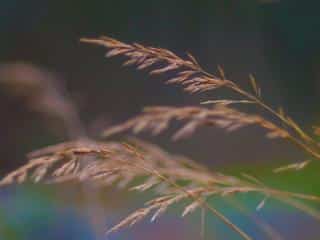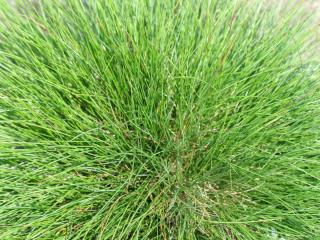

Fescue is a great contender for garden boxes and edges.
Key fescue facts:
Botanical name – Festuca sp.
Common name – fescue
Family – Poaceae
Type – grass
Height – 4 in to 3 feet (4 cm to 1 m), depending on species
Planting density – 4 to 10 plants per sq. yard (m²), depending on species
Exposure – Full sun to part sun
Soil – Light and well-draining, all pH levels
Flowering: usually in summer
Foliage – evergreen
Nearly all fescue grasses have grayish-blue or greenish-gray leaves. Depending on the species, the summer blooms are either tall and slender, or short with arching stems. Such diversity is there that you can easily create an entire landscaping bed just with plants of this family, and it will still look stunning.
This grass is excellent to decorate hard-to-plant areas. Indeed, it isn’t afraid of drought, and loves poor soil types: sandy and/or limestone.
Heavy soil, which usually have lots of clay, don’t suit it very well because they tend to retain too much water.
For this plant, it’s best to select a spot in full sun, but fescue will still adapt well to part shade.
Planting is best when done in spring or fall:
Fescue care is perhaps the simplest task of all. At the beginning of winter, you can remove wilted flowers, it’ll make the clump look neater. In spring, cut the clump back to renew leaves.
After a few years, if you find the plant has lost its luster, feel free to divide and split the one plant into two or three new ones.
Watering isn’t ever necessary, because Festuca hates having too much water.
Though fescue will easily grow from seed, you’ll get larger plants quicker by dividing the clump.

It’s possible to tear them apart by hand, but some gardeners prefer to slice them in half with a sharp spade.
Transplant each portion as described above in the “planting” section.
Fescue is a nearly invulnerable grass. Pests and diseases seem to never get a hold of it!
As is the case for many grasses, Festuca is at its best when planted in a group, either with other grasses, or with short perennials.
It’s very versatile and will match many settings: rocky terrain, alongside flower beds, or between stepping stones.
You’ll soon discover that blue fescue (Festuca glauca) is clearly the easiest fescue to get your hands on, but there are a few other species that are worth their while.
It got its name from the straight, dense foliage that can indeed prick through skin. Leaves are greenish-gray. Summer blooms, rather rare, have a beautiful light yellow hue.

It’s size never exceeds 4 inches (10 cm), and it grows to form a lush, soft cushion. Flowers appear in June-July, they’re the color of hay.
This species can reach a height of 3 feet (1 meter). Its foliage is wider, flatter than that of smaller species, and it’s shiny, too. Definitely different from the narrow blades of its cousins. Flowers, for this species, appear in the middle or at the end of summer. They’ve got a softer, wider shape and arch over as they grow longer.